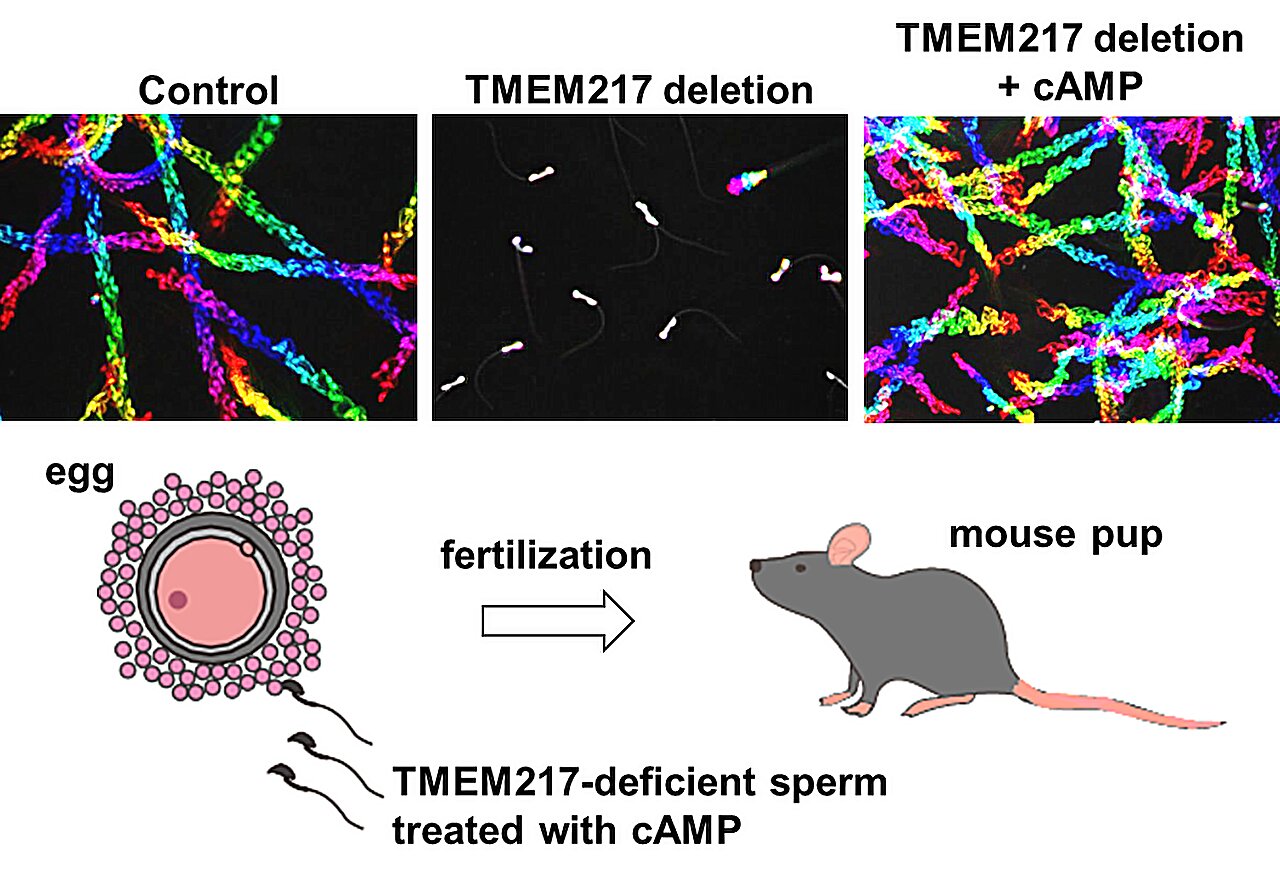Infertility touches the lives of millions of couples worldwide — a deeply emotional and often silent struggle that affects about one in every six partnerships. What many don’t realize is that in nearly half of these cases, the problem lies not with the woman, but with the man. In countless situations, the root of male infertility is heartbreakingly simple: sperm that cannot swim.
For a sperm cell, swimming is everything. It is the single defining mission of its existence — to journey through the female reproductive tract, reach the egg, and fuse with it to create new life. When that motion fails, life itself is halted before it can even begin. But now, a groundbreaking study from researchers at the University of Osaka has uncovered a vital clue — a molecular “switch” that keeps sperm in motion, and with it, the possibility of overcoming certain types of male infertility.
Published in the Proceedings of the National Academy of Sciences (PNAS), this discovery offers not just scientific insight but profound hope for the future of reproductive medicine.
The Mystery Behind Motion
Every sperm cell relies on its tail — known as the flagellum — to propel it forward. This tail doesn’t move by chance; it’s driven by precise biochemical signals that power its rhythmic whip-like motion. One molecule in particular, cyclic AMP (cAMP), acts as the spark of life, igniting the flagellum’s movement.
For years, scientists knew that an enzyme called soluble adenylyl cyclase (sAC) produces this essential cAMP signal inside sperm. Without sAC, sperm are powerless. However, the puzzle remained unsolved: how is this enzyme stabilized and sustained within the sperm cell? Why do some sperm lose this signal entirely, leading to immobility and infertility?
The Osaka research team decided to search for the missing piece of this molecular mystery — and their discovery would change the landscape of fertility science.
Discovering a Missing Partner
The team focused on a mysterious protein called TMEM217, found only in the testes and previously unstudied. To uncover its role, the researchers engineered mice that lacked the TMEM217 gene. The result was dramatic: these male mice were completely infertile. Their sperm were present — but they didn’t swim. They were alive, yet motionless, unable to carry out their fundamental purpose.
When the scientists looked closer, they made a striking discovery. TMEM217 forms a partnership with another protein called SLC9C1, creating a molecular complex essential for stabilizing sAC, the enzyme that generates the cAMP “go” signal. Without TMEM217, SLC9C1 collapses — and without both, sAC itself becomes unstable and nearly disappears.
The chain reaction is devastating: cAMP levels fall, the tail’s motor stalls, and the sperm fall still.
Reawakening Motion in the Lab
But what happened next in the lab was nothing short of astonishing. The researchers took the immotile sperm from the infertile mice and exposed them to a cAMP analog — a synthetic molecule designed to mimic natural cAMP.
Within moments, the sperm began to move again. The “dead” tails came to life, flicking and swimming energetically as if the missing switch had finally been flipped back on. Even more remarkably, when these reactivated sperm were used to fertilize eggs in vitro, healthy embryos developed — and the process resulted in the birth of normal, healthy pups.
It was a moment that symbolized not only scientific triumph but also a deeper metaphor: even when life seems motionless, sometimes all it takes is the right signal to restore its rhythm.
The TMEM217-SLC9C1-sAC Axis: A New Frontier in Male Fertility
The discovery of the TMEM217-SLC9C1-sAC axis is a fundamental leap forward in understanding how sperm maintain motility. This molecular “switch” represents a key mechanism that ensures the continuous production of cAMP, the very signal that keeps sperm swimming toward the egg.
When TMEM217 is missing, this delicate system collapses. By identifying its role, scientists now have a new target — both for diagnosing unexplained male infertility and potentially for developing new treatments.
As Professor Masahito Ikawa, senior author of the study, explained, “We pinpointed a simple way to restart immotile sperm by adding a cAMP analog. It’s an encouraging step toward practical options for some forms of male infertility.”
His words hint at a future where treatments for male infertility may go beyond hormones or surgery — toward molecular therapies that can directly “switch on” sperm motion.
From Mice to Men: What This Means for the Future
While this study was conducted in mice, its implications for humans are immense. Many cases of so-called “unexplained male infertility” may be linked to similar molecular breakdowns that prevent sperm from swimming properly. If scientists can identify defects in TMEM217, SLC9C1, or sAC in human sperm, it could revolutionize fertility diagnostics.
More importantly, treatments based on this discovery could one day offer hope to couples who have long struggled with infertility. A simple compound that restores cAMP signaling could potentially turn motionless sperm into viable, fertilizing cells — without the need for invasive procedures or donor sperm.
Of course, translating such findings from mice to humans will require extensive research, ethical consideration, and clinical testing. But the concept itself — reviving life by restoring a molecular signal — opens doors that were once closed.
The Emotional Dimension of Discovery
Behind every scientific breakthrough lies a human story. Infertility is not just a medical condition; it is a deeply emotional journey filled with hope, loss, and longing. For many couples, the inability to conceive is one of life’s most painful challenges, striking at the heart of identity, love, and dreams for the future.
Discoveries like this one from Osaka are more than laboratory triumphs — they are sparks of hope that reach into the lives of people around the world. The idea that scientists could one day “reawaken” sperm, giving couples a chance to create the life they’ve long wished for, resonates far beyond the pages of a scientific journal.
A Window Into the Miracle of Life
At its core, this study reminds us of how fragile and wondrous the process of life truly is. The simple act of conception — something often taken for granted — depends on the precise orchestration of countless molecules within a single cell.
A sperm’s journey is nothing short of heroic: it must navigate complex environments, survive chemical shifts, and swim with relentless determination toward the egg. To learn that this incredible movement relies on a microscopic “switch” — one that can fail or be restored — deepens our appreciation for both the mystery and the mastery of biology.
Every birth, every heartbeat, and every moment of life begins with that motion.
The Hope Ahead
As research continues, the discovery of the TMEM217-SLC9C1-sAC complex may mark the beginning of a new chapter in reproductive medicine. It offers not just an explanation for certain cases of male infertility, but a potential way to overcome them.
More broadly, it reflects a growing era of precision medicine — where scientists can target specific molecular pathways to heal, restore, and even create life. With compassion guiding science, and innovation grounded in ethics, the dream of giving more couples the chance to hold their own child may soon move from possibility to reality.
More information: Formation of a complex between TMEM217 and the sodium-proton exchanger SLC9C1 is crucial for mouse sperm motility and male fertility, Proceedings of the National Academy of Sciences (2025). DOI: 10.1073/pnas.2516573122






